How To Do Your Due Diligence On Flippa To Avoid Getting Scammed!
Flippa is the leading auction site for websites, domains and apps. You can bid on starter sites with zero income or traffic upto million dollar sites. However, don’t fall into the trap that many do and spend good money on something that is a scam.
I am a premium seller on Flippa with 100% feedback and over $80,000 worth of transactions. I have a lot of experience through the years with how Flippa works and how to spot a good deal or a scam. I will share my tips with you to help you make the best out of Flippa and avoid being scammed.
When you start browsing on Flippa for a website to buy you will find hundreds, if not thousands of listings. The marketplace is flooded with websites in all sorts of niches. Most of the starter websites have no traffic and no revenue. So lets start and narrow your search on Flippa to find listings that are worth bidding on.
You are not gonna get rich buying a “Fully automated content or blog site”. You will find in the starter site section around 70% of the listings are of such. They simply grab content from other sites and repost them as blogs onto the site to generate content of which none is unique. Adsense will not allow you to put ads on this type of site so monetization is limited and Google will eventually remove the site from any rankings it might have had with a “duplicate content” penalty.
If Adsense is already on that site, it will probably not last too long before Google ban the site from Adsense, putting your entire account at risk of termination. Google now verifies any site before accepting it into the Adsense program. Many sites from the end of 2018 may have Adsense but unverified by Google and could be banned at any time as they run their checks.
So that brings us down to around 30% of the starter sites left on Flippa.
Let’s take a look at an example listing that looks great and well worth paying $1000 for. Many would fall into this trap but doing due diligence will start the alarm bells ringing. If you find a site that is earning almost $300 in Adsense and could potentially be yours for $1000 you would automatically jump at the chance to own it. 3 months and you would have your investment back, anything after is pure profit.
Sounds great however, a genuine $300 per month Adsense site would actually go for the higher end of $4,000 possibly even higher. 12 months multiplied by revenue is around the price tag of any genuine Adsense verified website.
This is a listing I found, one of many from the same seller.
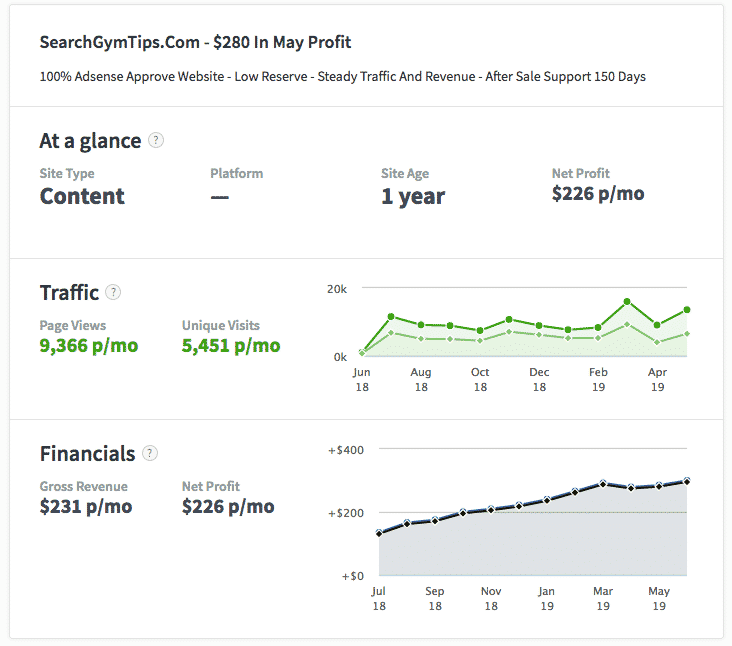

That site sold for $950 so the buyer is thinking, I’ll get my money back in less than 4 months because the site is growing and almost making $250 a month. I feel sorry for these people but they should not be in Flipping business if they can’t be bothered to do their due diligence to the basic level.
Why is this site likely to be a scam site?
The screenshot below is the traffic stats, check the bounce rate:
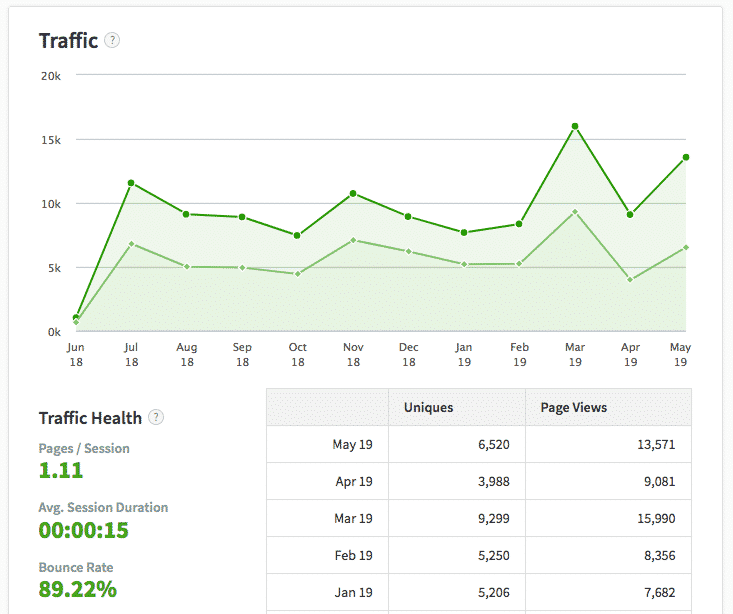
Over 89% of this websites traffic bounces. That means the visitor will just go to one page for a couple of seconds and leave. As most of the claimed traffic is “Organic” traffic, you would think that anyone looking for this site would spend more than a couple of seconds viewing it.
Organic traffic is real people searching for a web page and landing on a page that should be what they are looking for in the first place. There is no possible way that organic traffic would ever have such a high bounce rate unless some sort of blackhat method is being used to generate traffic.
Now we need to see what priority pages are indexed in Google so we use site:domainame in a Google search to find the most popular pages currently indexed on the first page.

You would expect to see the main site domain pages for the site content not what we see below:
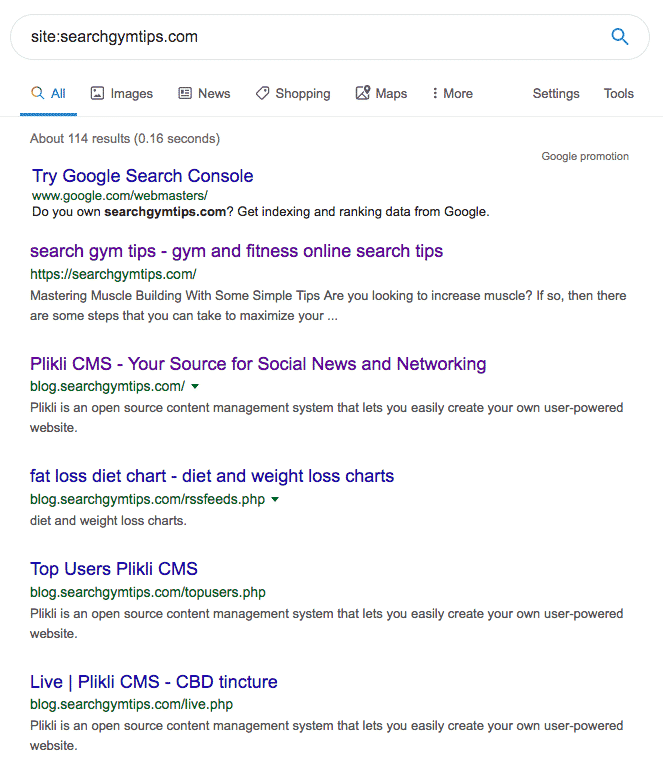
The “blog” subdomain literally is all that’s indexed in Google and nothing from the main website pages. Most of the content from the sub domain is also not relevant at all to the website niche. So I took a look at what the blog subdomain actually is. It is a Plikli CMS blog that allows anyone to share content from the web in an online community.
This type of CMS can generate huge amounts of traffic due to the spam nature of the CMS. There are literally thousands of pages full of spam links and non related content all linking back to the main domain homepage. The spam links are placed on the subdomain by people using software creating backlinks to their own site.
How does this generate organic traffic? Well, what the seller had done to the CMS is modify it so that every spam link didn’t actually link back to the spammer, it linked to another webpage on the root domain. Software such as GSA Search Engine Ranker use proxies to search Google and Bing to find sites to post to. Each time the subdomain appeared in a search engine, the software would click it, make a post and verify it by clicking the link.
- The software uses Google to find a Plikli CMS or spam site to post to.
- The Plikli site appears for the search term entered into Google by the software.
- The software clicks that link.
- The click is classed as organic because it came from a search engine click.
- The software makes the post.
- The software verifies the post by clicking the link.
- The software opens the page on the main domain rather than the posted link.
- It is all done in less than 20 seconds and counts as organic traffic although generated by software. This is fake organic traffic.
Always ask the seller for access to Google Analytics.
Any genuine seller on Flippa should have nothing to hide. They can easily add you to their Google Analytics property so you can view the traffic and all data from the past and present. You need to see what keywords are being used to bring people to your website via search engines. It’s no good having thousands of people typing “Buy Jerseys Online” coming to your blog about fish. I asked this seller to grant me access to his Google Analytics and he did not respond. He did respond to my message when I called out his scam to him though.
I guarantee all that traffic is fake traffic generated by search engine ranking software hitting keywords not related to the niche. If it wasn’t then why not grant me access to analytics so I can see for myself?
All the traffic on that listing is mostly coming from the subdomain and landing on another page on the root domain, all done by software and not a real human being in sight!
If a seller does not grant you access to Analytics, simply leave and don’t bid on that website!
So how is the site making so much money on Adsense if the traffic is fake?
Flippa has a great feature that helps separate the scammers from the genuine sellers. It not only allows sellers to verify their Google Analytics but also verify their Adsense earnings. The system works by connecting your Flippa account to Adsense and grabbing all the necessary data to show valid earnings for the past 12 months. This cannot be faked. If a website boasts Adsense earnings and the seller does not verify Adsense earnings by using Flippa’s verification system that takes 2 minutes to do, you have to wonder why.
You will find near the bottom of any auction on Flippa the claimed revenue or verified revenue. Don’t get confused, claimed revenue is what the seller claims the website is earning, verified revenue is genuinely what the website is earning. The screenshot below is taken from the auction mentioned on this post.
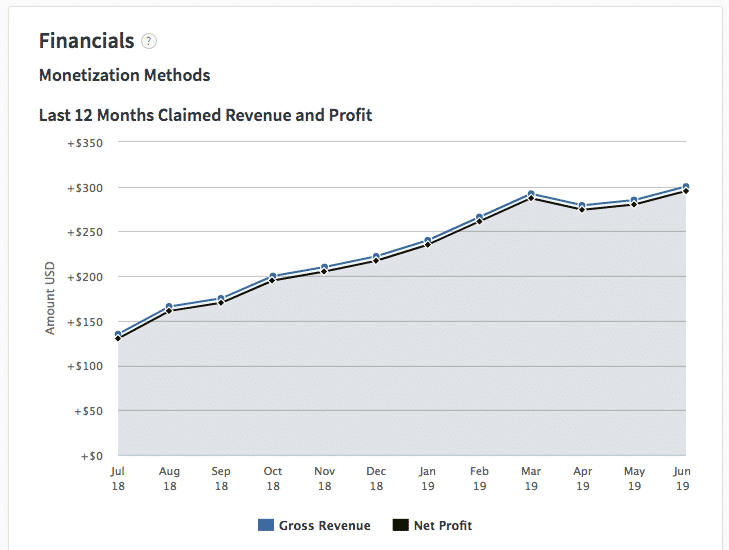
Blue Line = Claimed Revenue – Green Line = Verified Revenue
The blue line is what we are looking at here, that is the “claimed Adsense revenue”. If it was verified Adsense the blue line would be green.
I asked the seller why they have not bothered to verify Adsense and their reply was “I don’t need to I have screenshots and can give you a video walkthrough”. Not the correct answer to give an experienced buyer or anyone with half common sense! I mean it takes just 2 minutes to verify Adsense revenue on Flippa!
- Screenshots can easily be faked.
- Video walkthroughs can also be faked.
- Seller will not verify Adsense earnings using Flippa’s verification system.
So the seller is hiding something. Maybe the earnings are real, afterall, a buyer can dispute the sale. However, even if the Adsense earnings are real, there is no guarantee that your Adsense account will accept the same site. That’s not the sellers fault, what happens after the website is sold is your business. If an ads network doesn’t want to work with you then that’s your problem. The site was displaying Adsense before each site was verified by Google at the end of 2018. That took me to another screenshot on the listing..
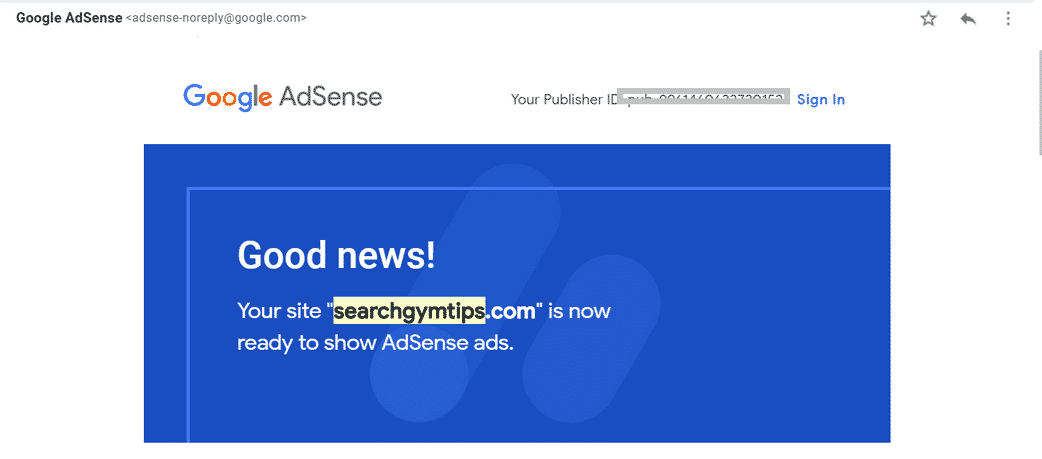
Good news! Your site “*************.com” is now ready to show AdSense ads. It looks like a genuine email, however, where is the date? If you have a Gmail account you will notice that next to the “Star” icon on the top right is the date of when the email landed in your inbox.
No Date on Gmail Email:
![]()
How the Date is Displayed on a Genuine Gmail Email:
![]()
The Adsense acceptance proof email has no date, it has most probably been used as the same template for all the sellers Adsense sites. All they did here was type out the domain name on a text editor, highlight it, screenshot it and photoshop it onto the Adsense acceptance email template. That template was probably taken from an image search on Google or copied from a previous site’s acceptance.
- No date on the email to prove when the site was accepted by Adsense.
- Site boasts Adsense earnings since before single site acceptance emails were sent.
- Could be the first site acceptance email however all the sites in the sellers portfolio show the same screenshot with only the URL changed.
What I had to do here was go into the sellers other listings to see if there was any similar pattern. Yes everything on this page is similar to all of the sellers listings and as of writing this, there are 5 live listings by the same seller.
Always check the sellers feedback and previous sales.
A seller that has 100% positive feedback on more than 10 listings is normally someone you can trust. However, there are a couple of things you need to consider:
- How many sales has the seller successfully sold?
- How many of the sellers sales actually have feedback?
The seller might have sold 100 sites and only 10 people were happy enough to leave feedback. Many buyers on Flippa purchase a lot of websites over a short amount of time. They will then take their time working on each one, one at a time. It could take some time for the buyer to actually get around to the purchase and start work on the website or even take a look at what they bought.
If its a dead website, it’s just a small loss to a rich buyer on Flippa. Chances are they are too busy on a much higher revenue generating website. Not everyone bothers to leave feedback on Flippa and many wouldn’t want to be negative with a buyer incase of any reputation loss for both buyer and seller.
Always check a sellers previous sales and listings. Try to find something that is similar in each listing and investigate reasons for why there is a similarity. It could be a blackhat method to generate traffic, it could be false earnings, fake screenshots etc. A seller with more sales and a higher ratio of positive feedback (the buyer was so happy they felt the seller deserved positive feedback) is less likely to be a scammer to the one with a low ratio of positive feedback.
Another way scammer sellers can get 100% positive feedback is by creating fake accounts, bidding and winning on their own auctions. If you look at the seller mentioned on this post, you will see that the majority of his auctions are bought by sellers who have been members of Flippa for almost the exact same time. We cannot see if the same bidders have been used to up the price, however, I am quite certain there will be a pattern there. Seller bids on his own auction with his fake accounts and technically sells them to himself, leaving 100% positive feedback on every sale.
The cost for this is roughly $9 listing fee plus 10%. So each 100% positive feedback costs around $109. He builds up a nice looking trusting profile and re-lists the same sites later on. Buyers trust his profile and it only takes 1 buyer at $950 to earn the scammer a profit. Out of his $18,000 sales, probably only $2,000 is profit, that $2,000 cost $1,000 to make. Seller has ran a scam that made him $1,000, possibly more if any of his other sales were actually real sales.
So a summary of how to do due diligence on Flippa to avoid getting scammed:
- Check the traffic and bounce rate. A bounce rate of over 70% is high.
- Do site:domainname in a Google search to find what pages are indexed on the first page. Make sure it is all main root domain pages and not a subdomain with unrelated posts.
- Ask the seller for access to their Google Analytics so you can inspect the traffic to find what keywords are bringing in the organic traffic. Check to see if there is a lot of organic traffic coming from the same city. There is software that can generate fake organic traffic and most of it will come from a couple of cities, not scattered all around the world. If the seller refuses to give you access, just move on to the next auction and forget this one.
- If the seller boasts Adsense earnings and doesn’t verify it through Flippa, ask the seller to use Flippa’s verification system. If the seller refuses, even if they offer you a video walk through, forget it and move on.
- Always check the screenshots for anything that can be photoshopped. Compare them with the sellers other listings.
- Make sure that both traffic and revenue are showing an upward direction. Don’t buy a website that has huge traffic for 1 to 3 months near the beginning and then a big fall or complete inconsistency.
- If you have any doubt whatsoever, ask the seller and get valid proof. If the site is making money from anything other than Adsense, you can always use something like Teamviewer to connect to the sellers computer and walk yourself through all the accounts to check everything.
There are many other points to routing out the scammers on Flippa but I think I have covered the main points when buying a website on Flippa. If you stick to this, you should be able to find a genuinely good profitable website that you will enjoy working with. Remember that the going rate should be around 12 months worth of the website profit. Anything below that then you have done well, as long as the profit hasn’t started to drop off over the previous 6 months or so. You want an upward arrow of both traffic and revenue.
I hope this post helps many people in the Flipping business.
Thank you for reading.
